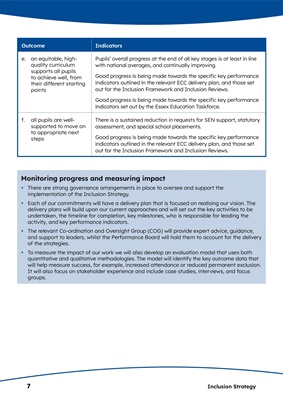
7 Inclusion Strategy
Outcome Indicators
e. an equitable, highquality curriculum
supports all pupils
to achieve well, from
their different starting
points
Pupils' overall progress at the end of all key stages is at least in line
with national averages, and continually improving.
Good progress is being made towards the specific key performance
indicators outlined in the relevant ECC delivery plan, and those set
out for the Inclusion Framework and Inclusion Reviews.
Good progress is being made towards the specific key performance
indicators set out by the Essex Education Taskforce.
f. all pupils are wellsupported
to move on
to appropriate next
steps
There is a sustained reduction in requests for SEN support, statutory
assessment, and special school placements.
Good progress is being made towards the specific key performance
indicators outlined in the relevant ECC delivery plan, and those set
out for the Inclusion Framework and Inclusion Reviews.
Monitoring progress and measuring impact
y There are strong governance arrangements in place to oversee and support the
implementation of the Inclusion Strategy.
y Each of our commitments will have a delivery plan that is focused on realising our vision. The
delivery plans will build upon our current approaches and will set out the key activities to be
undertaken, the timeline for completion, key milestones, who is responsible for leading the
activity, and key performance indicators.
y The relevant Co-ordination and Oversight Group (COG) will provide expert advice, guidance,
and support to leaders, whilst the Performance Board will hold them to account for the delivery
of the strategies.
y To measure the impact of our work we will also develop an evaluation model that uses both
quantitative and qualitative methodologies. The model will identify the key outcome data that
will help measure success, for example, increased attendance or reduced permanent exclusion.
It will also focus on stakeholder experience and include case studies, interviews, and focus
groups.